Alongside sustainability and climate action, biodiversity conservation is one of the most important issues of our time. Scientists describe the loss of biodiversity as a threat that could affect humanity even more than the climate crisis. It threatens not only food security, but also plant life and stability of ecosystems. For too long, we in the construction and property industry have paid too little attention to the qualities of exterior spaces. We have paid too little attention to the extinction of species and seen no connection to our actions. But there are many opportunities in the building sector to make a positive contribution. For this reason, the DGNB, in close cooperation with the Lake Constance Foundation and with the involvement of numerous experts, has developed a certification system that addresses precisely this issue.
The DGNB System for Biodiversity-Promoting Exterior Spaces helps companies, municipalities and district developers to design and maintain exteriors, façades and roofs in a way that supports the conservation of species and ecosystem diversity and has a demonstrable positive impact on biodiversity at the site. The certificate provides transparency on the quality of biodiversity-promoting exterior spaces and can be used as evidence for reporting requirements.
The certification is aimed at all stakeholders who have access to building- or district-related exterior spaces or those who plan, design and maintain them. In particular, the system is aimed at economic actors such as businesses, as well as those who design living spaces, such as local authorities and district developers.
The new system has been developed with two priorities in mind. On the one hand, the system aims to promote biodiversity at the sites as well as a holistic, sustainable optimisation of exterior spaces. The biodiversity-promoting content was developed with a group of experts and a project advisory board in cooperation with the Lake Constance Foundation. Numerous workshops and tests on real projects have led to the present result.
On the other hand, the system includes criteria with a holistic perspective on other sustainability issues. These were implemented based on the experience and methods of other DGNB Systems. The contents of the DGNB System for Districts and the various DGNB Systems regarding buildings have been incorporated directly into the new system variant, thus ensuring maximum connectivity and practicality.
With its certificate for biodiversity-promoting exterior spaces, the DGNB aims for:
- Raising awareness of biodiversity loss
- Presenting practical assessment methods and effective solutions for promoting biodiversity
- Establishment of monitoring of relevant information and continuous improvement as a process in the care and maintenance as well as the management of exterior spaces
- Holistic design and optimisation of exterior spaces in terms of sustainability and biodiversity
- Incorporating social and long-term sustainability aspects into projects
- Minimising the risk of bad investments and creating transparency
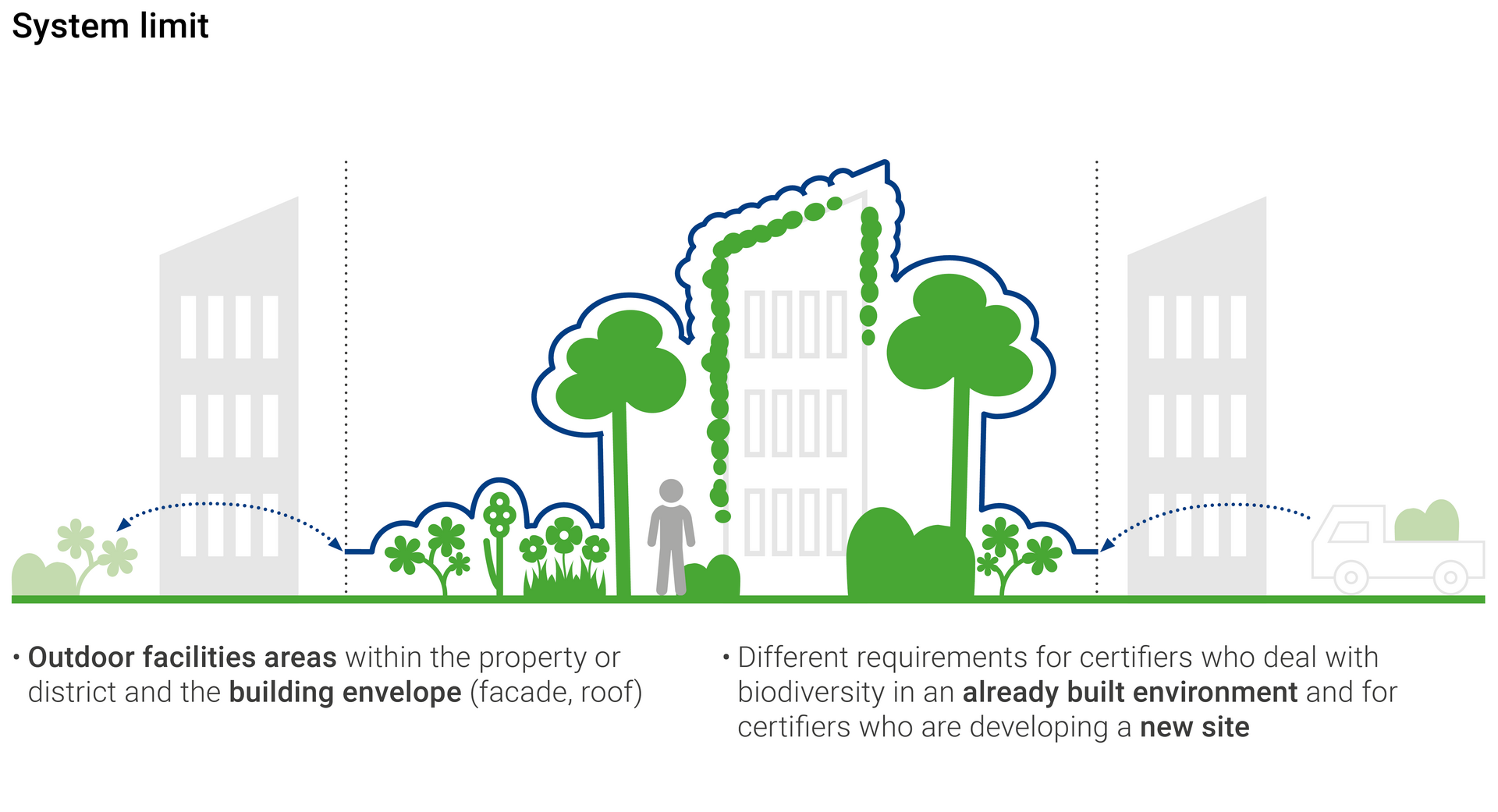
The DGNB System Biodiversity-Promoting Exterior Spaces is applicable to outdoor areas related to both buildings and districts. As part of the certification, ground-level outdoor spaces as well as the building envelope (roof and façade) are assessed. This means that all areas which can be designed to promote biodiversity — either on a building or within a district — are evaluated. The system differentiates between exterior spaces in existing urban structures and those in newly developed ones. The reason for this distinction is that new building projects typically offer more opportunities to implement comprehensive biodiversity-promoting measures, such as those involving the building envelope, compared to existing buildings. The evaluation covers the planning process, the implementation phase, and the use of the outdoor space at the respective time of certification.
General benefits / advantages:
Biodiversity-promoting exterior spaces...
- have a demonstrably positive impact on on-site biodiversity.
- create livable environments.
- mitigate the impacts of climate change.
- create identification and a sense of belonging.
- protect the soil.
- support future European and national targets relating to the conservation and restoration of biodiversity.
Benefits for economic actors:
- Demonstrating a sense of responsibility
- Good preparation for upcoming regulations
- Use of the certificate in reporting obligations
- Use of the certification for communication purposes
Benefits for habitat designers:
- Protection of natural resources – for generations to come
- Climate change adaptation
- Preparation for upcoming regulations
- Eligibility for (future) subsidies
The criteria and their weighting
The criteria set for biodiversity-promoting exterior spaces consists of nine criteria, listed below, which belong to the three topic areas of environmental quality, economic quality and socio-cultural and functional quality.
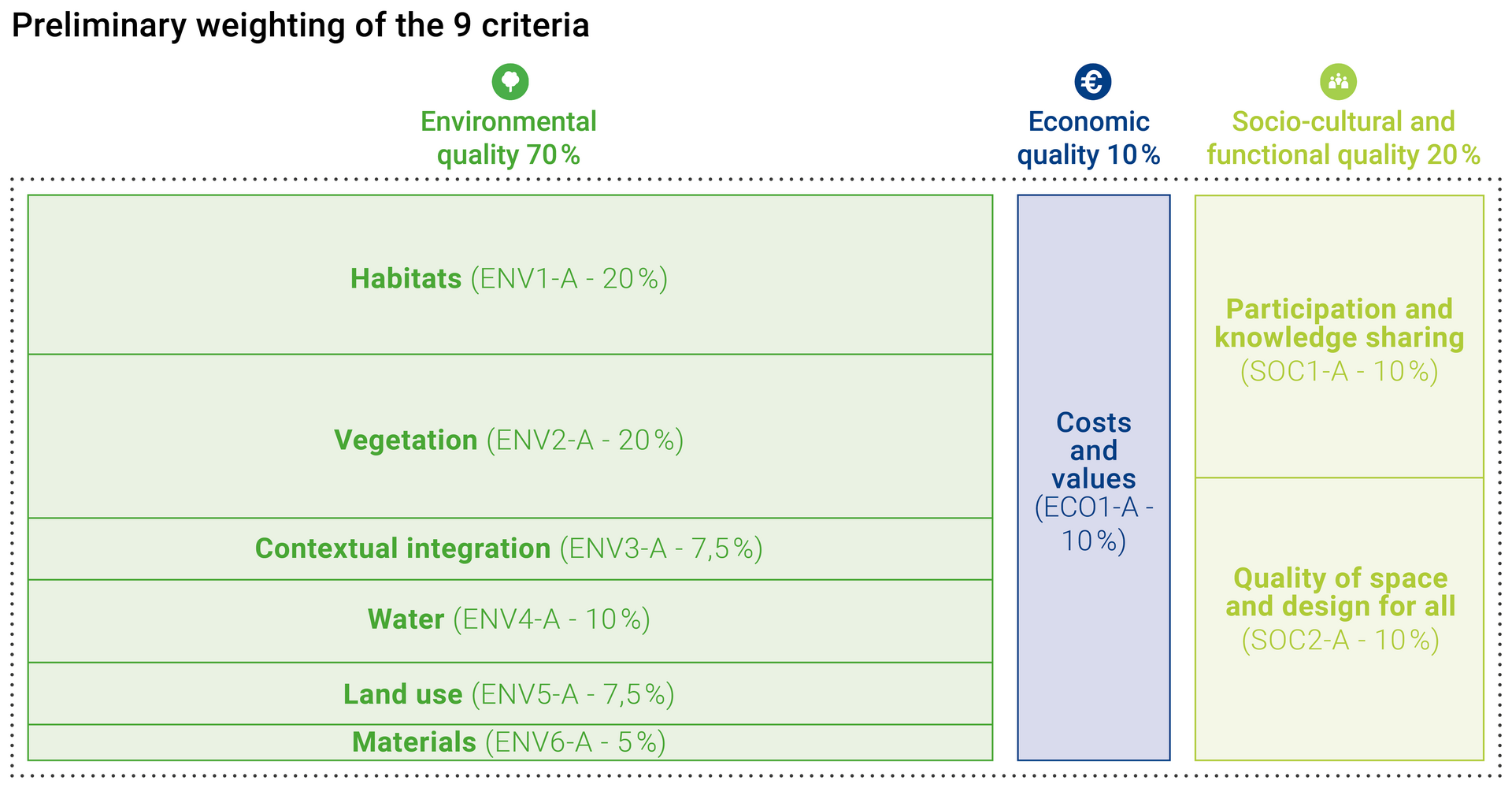
Weighting of the topic areas:
- Environmental quality: 70%
- Economic quality: 10%
- Socio-cultural and functional quality: 20%
The criteria themselves are weighted as follows:
- ENV1-A Habitats: 20%
- ENV2-A Vegetation: 20%
- ENV3-A Contextual integration: 7,5%
- ENV4-A Water: 10%
- ENV5-A Land use: 7,5%
- ENV6-A Materials: 5%
- ECO1-A Costs and values: 10%
- SOC1-A Participation and knowledge sharing: 10%
- SOC2-A Quality of spaces and design for all: 10%
The certification process is divided into four phases. The indicators within the criteria are also assigned to these four phases. The four phases describe the planning, implementation and use of an exterior space. The planning process is divided into two phases: A Stocktaking and B Conceptional planning. The implementation process is evaluated in phase C Implementation and the use in phase D Operation and maintenance.
The certificate can be obtained after completion of the implementation (phase C). The phases preceding implementation, Inventory (phase A) and Conceptional planning (phase B), provide incentives to deal with sustainability aspects in the early project stages. As exterior spaces can only promote biodiversity in the long term if ecological upkeep takes place during use (phase D), continuous recertification is planned. One year after receiving the certificate, confirmation of the certificate is required, which is then due every three years.
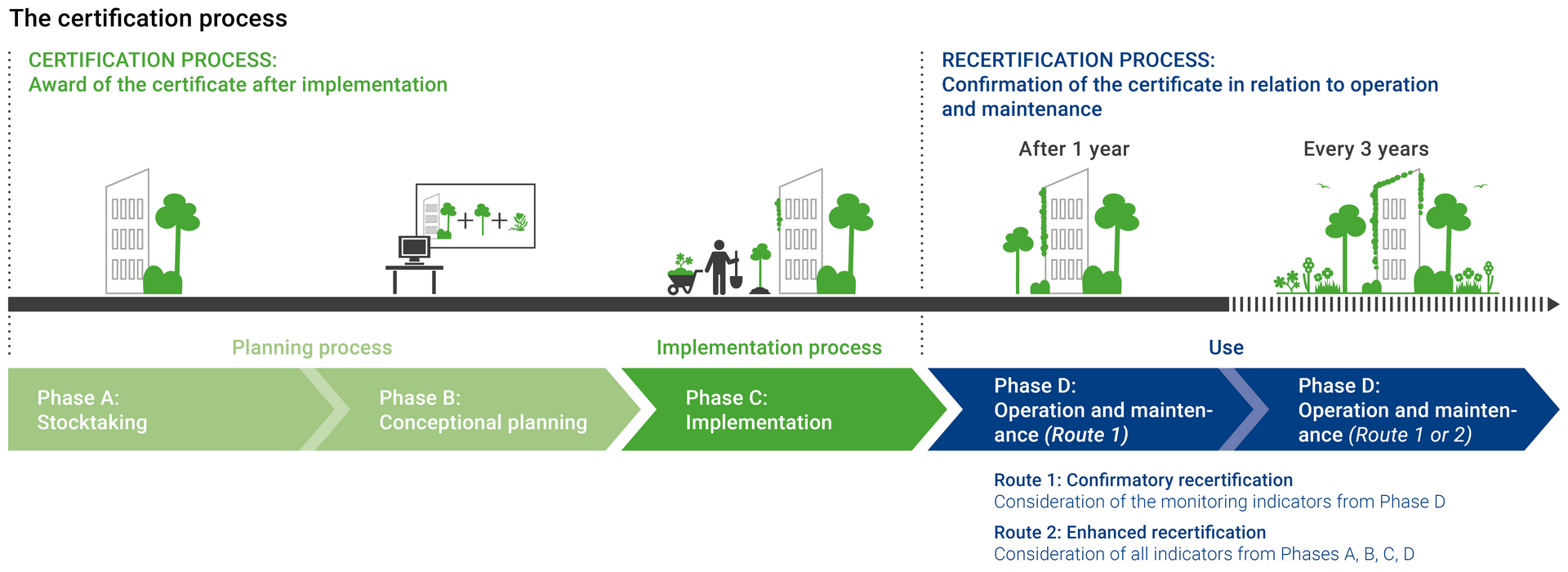
Initial Certification
In order to obtain the first DGNB Certificate, the exterior space must be complete at the time of submission of the verification for conformity check and must not conflict with the applicable legal regulations. The indicators from phases A, B and C must be taken into account. For the purposes of certification, it is irrelevant whether the qualities were already present (existing building) or were newly built. The first DGNB Certificate for Biodiversity-Promoting Exterior Spaces is valid for one year.
Recertification
Exterior spaces can only promote biodiversity in the long term if ecologically upkeep takes place regularly. For this reason, the functions of biodiversity-promoting exterior spaces are reviewed and readjusted as necessary. Early readjustment of the ecological upkeep can save costs. In order to use the award beyond the planning and implementation phase, a first confirmatory recertification is mandatory after one year. This is already included in the certification costs. Subsequently, a confirmatory or enhanced recertification is then required every three years.
- Route 1: Confirmatory recertification
The indicators from phase D that are assigned to monitoring and whose content-related indicators from previous phases have already been addressed must be considered. At a minimum, however, the indicators Functional assessment of habitats (ENV1-A Habitats, indicator 1.4.1) and Biodiversity-promoting upkeep (ENV2-A Vegetation, indicator 1.4.1) should be considered. - Route 2: Enhanced recertification
If the aim is to improve the award level, the entire certification process, i.e. all indicators from phases A, B and C, must be repeated. Indicators that have not changed can be recognised directly.
In both cases the recertificate is valid for three years.
Pre-certificate for district-related exterior spaces
The development of district-related exterior spaces extends over a long period of time, during which ownership often changes. A pre-certificate can therefore be issued at the level of an urban design. Phases A and B should be considered, as well as preparatory phase C and any aspects of phase C that have already been implemented at the time of pre-certification.
Minimum requirements are defined in the criteria ENV1-A Habitats and ENV2-A Vegetation. Fulfilment of these is mandatory in order to be certified. The minimum requirements of criterion ENV1-A are relevant for initial certification, while the minimum requirements of criterion ENV2-A apply for recertification.
- ENV1-A Habitats: Projects can only be certified if a certain minimum proportion of the exterior space is designed to promote biodiversity. For projects that are already located in a built environment, this required minimum proportion is 30 percent, otherwise it is 40 percent. Areas on façades and roofs that contribute to biodiversity can also be counted.
- ENV2-A Vegetation: In the course of recertification, evidence of biodiversity-promoting upkeep must be provided. An assessment by an independent expert based on a guideline and, if applicable, a list of measures for improvement must be submitted.
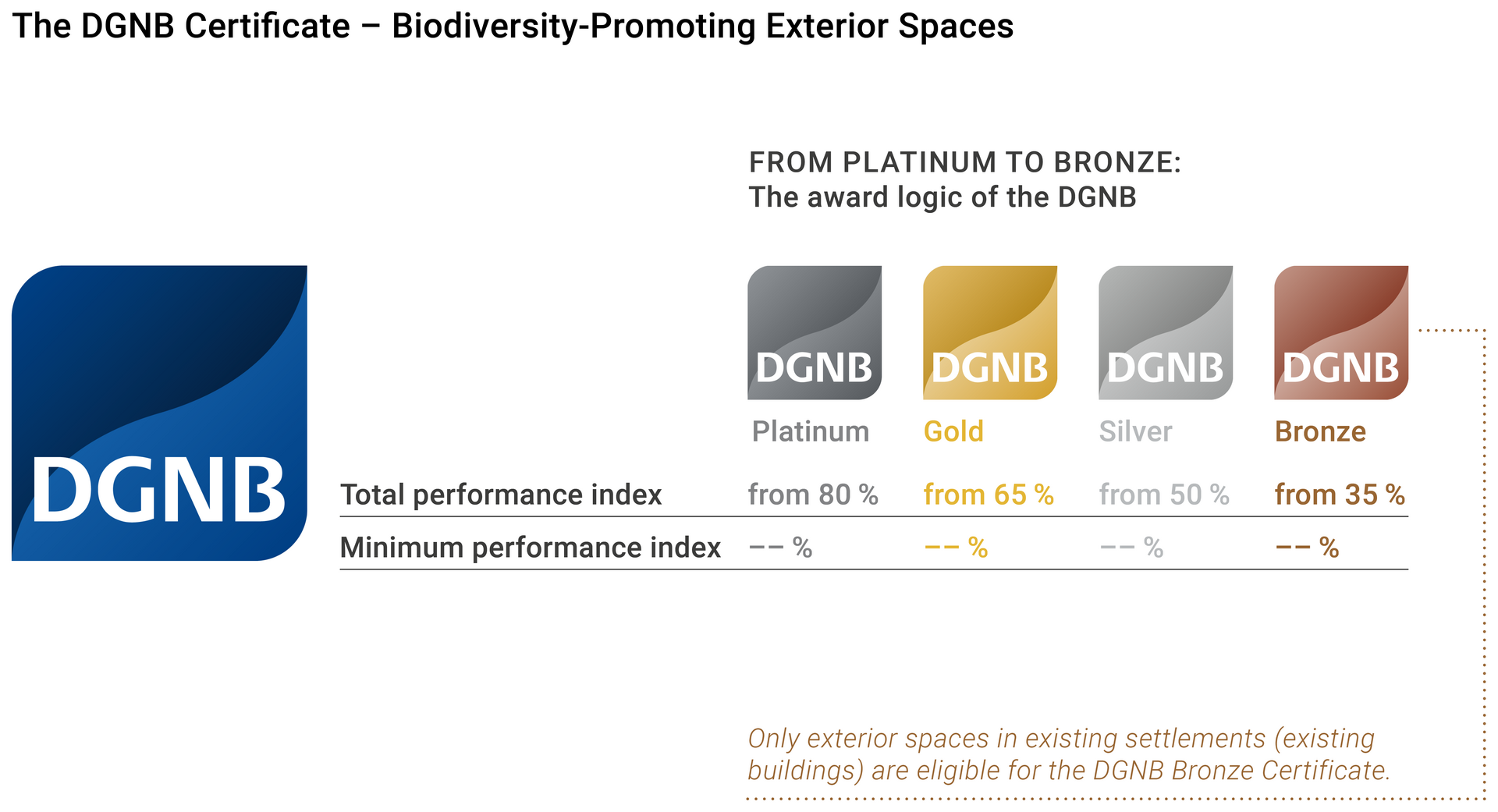
The DGNB System evaluates based on degrees of fulfilment. The overall degree of fulfilment is calculated from the assessments of the individual criteria within the three topic areas, taking into account their respective weightings.. The highest award is the platinum certificate. During the operation and maintenance phase, the overall degree of fulfilment can be improved by an enhanced recertification (see "Certification and validity").
Biodiversity-Promoting Exterior Spaces with an overall degree of fulfilment of 35 percent or more are awarded the DGNB Certificate Bronze. This award level can only be granted to projects in existing settlements (existing buildings). From an overall degree of fulfilment of 50 percent, the DGNB Silver is awarded. For a DGNB Gold, the project must achieve an overall degree of fulfilment of 65 percent or more and from an overall degree of fulfilment of 80 percent, the DGNB Certificate Platinum is awarded. No minimum degree of fulfilment per topic area is required during the pilot phase.
The certification fees are staggered according to the area of the property and are set as follows during the pilot phase:
Registration and check:
| Plot area in m2 up to | DGNB member* and SME** | Non-member* |
|---|---|---|
| < 10.000 | 3,500 € | 4,500 € |
| < 100.000 | 4,500 € | 5,500 € |
| > 100.000 | on request | on request |
*All prices plus VAT
** SME = Small and medium-sized enterprises
Note: Various funding programmes are available from the Kreditanstalt für Wiederaufbau (KfW) for the design and implementation of biodiversity-promoting exterior spaces. These include the 444 and 240/241 programmes (both websites are available in German only).
Recertification/ from the 2nd year after completion:
| Plot area in m2 bis zu | DGNB member* und SME** | Non-member* |
|---|---|---|
| < 10.000 | 700 € per year | 900 € per year |
| < 100.000 | 900 € per year | 1,100 € per year |
| > 100.000 | on request | on request |
*All prices plus VAT
** SME = Small and medium-sized enterprises
Project registration
The system will be applied to the first projects in the pilot phase, during which final testing of the system will take place. Interested parties have the opportunity to actively participate with their projects.
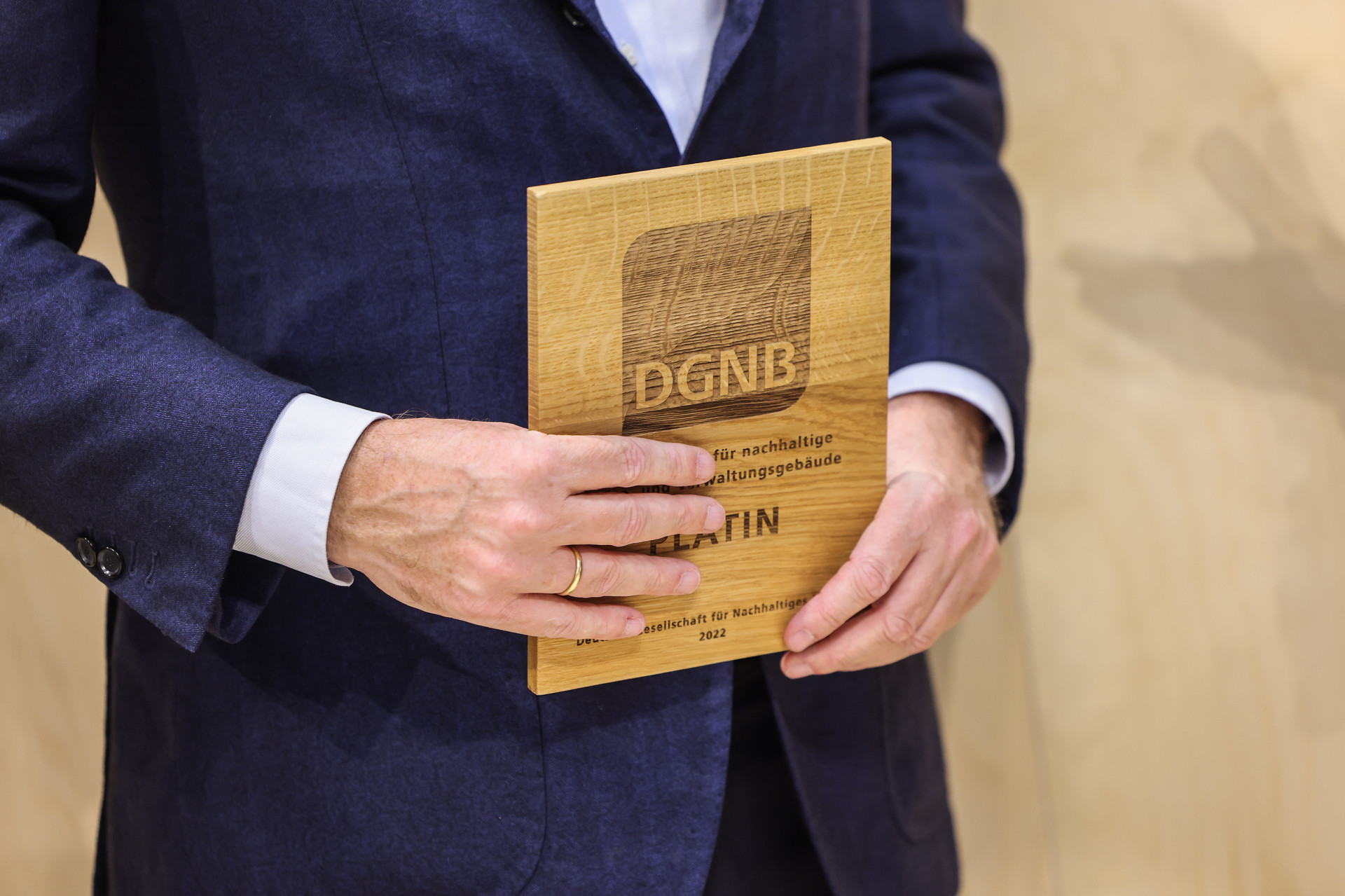
Projects seeking certification can be registered via the DGNB System Software.
The audit is carried out by a DGNB Biodiversity Manager appointed by the client. After consultation with the DGNB, the audit can also be carried out by other persons as part of the initial application. Please do not hesitate to contact us. You can reach us at biodiversitaet@dgnb.de.
Frequently asked questions
A final assessment of whether the measures have been successfully implemented can only be made after a certain growth period. In addition, qualified, ecological upkeep of the exterior spaces is required so that they can actually realise their potential in terms of biodiversity. For this reason, the DGNB Certificate for Biodiversity-Promoting Exterior Spaces has a limited validity. In order to be able to use the award beyond the planning and realisation period, a confirmatory recertification is mandatory after one year. Recertification must take place every three years thereafter. Projects can either confirm or even improve their result, depending on the scope of the recertification (Route 1 or Route 2).
Recertification benefits at a glance:
- Monitoring of relevant information and the possibility of continuous improvement of the ecological value through the maintenance and management of (to be) certified exterior spaces
- Avoid risks of bad investments and create transparency
- Proven long-term safeguarding of the ecological value
- Communication opportunity and integration into sustainability reporting
Yes, according to the EU, the main causes of biodiversity loss are changes in land use, climate change, the exploitation of resources, environmental pollution and the spread of invasive species. The construction and real estate industry can have a direct or indirect influence on all of these causes and thus also make a contribution to biodiversity.
Yes. The system can be applied to both existing and newly created exterior spaces. The condition of the exterior space at the time of submission of the certification documents is assessed, regardless of whether the area has been redesigned or not. In addition to the distinction between exterior spaces in existing and newly developed urban structures, a differentiation is also made between district-related and building-related exterior spaces. For any questions, please contact biodiversitaet@dgnb.de.
For the presentation and optimisation of effective and meaningful biodiversity-promoting projects, it makes sense to also strive for certification of the exterior space. We recommend this for larger exterior spaces in particular. How points from the certification of new constructions or districts can be credited is currently still being worked on. If you have any questions, please contact biodiverstaet@dgnb.de
Yes. Please switch to German language settings to see all information about the DGNB Biodiversity Manager.
The DGNB has developed a tool specifically for this variant of DGNB Certification. We will be happy to send it to you as part of the project registration process or on request at biodiversitaet@dgnb.de. Please note: Currently, no English version of the tool is available. But the German version can be requested.
The catalogue of criteriacriteria set can be used to assess "building-related exterior spaces" and "district-related exterior spaces". These differ in a few indicators in the requirements. District-related exterior spaces have a different influence on biodiversity due to the availability of space, e.g. along infrastructure.
The use of the buildings is not relevant for differentiating between the schemes.
The criteria set was not tested for other possible applications such as parks without a district connection, inner-city public spaces or similar.
Properties or developments that gain DGNB Certification for Biodiversity-Promoting Exterior Spaces are eligible for preferential funding terms. The KfW Environmental Programme (ref. 240 & 241) supports the implementation of measures that promote environmental protection and resource efficiency. In addition, KfW's Natural Climate Action in Municipalities Programme (ref. 444) promotes biodiversity and the development of green spaces in residential areas.
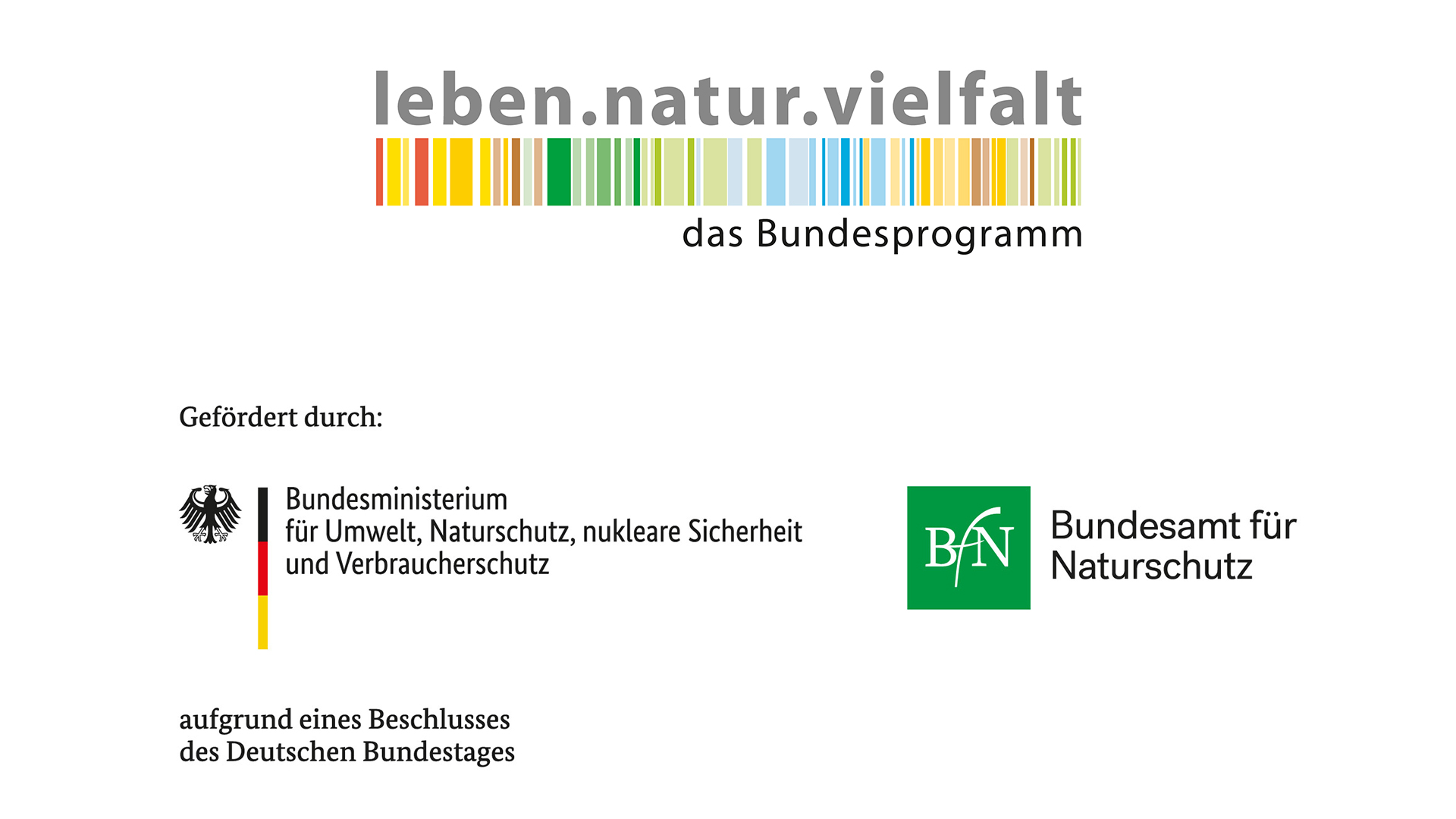
The certification was developed in close cooperation with the Lake Constance Foundation as part of the "Unternehmen Biologische Vielfalt (UBi)" project (e.g. "Companies and biodiversity"). The UBi project is funded within the Federal Programme for Biological Diversity by the Federal Agency for Nature Conservation with resources from the Federal Ministry for the Environment, Nature Conservation, Nuclear Safety and Consumer Protection.
In addition, around 40 experts from a wide range of fields have been involved in conceptualising the system over the past two years.
Your contacts
Carla Schweizer
Project Manager Research Projects
- Phone: +49-711-722322-90
- Email: C.SCHWEIZER@DGNB.DE
